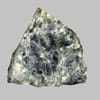Definition
Dacite is a volcanic igneous rock which is rintermediate in composition between andesite and rhyolite
Troctolite is a mafic intrusive rock type. It consists essentially of major but variable amounts of olivine and calcic plagioclase along with minor pyroxene. It is an olivine-rich anorthosite, or a pyroxene-depleted relative of gabbro
Origin
Romania and Moldova, Europe
Unknown
Discoverer
Unknown
Christian Leopold von Buch
Etymology
From Dacia, a province of the Roman Empire which lay between the Danube River and Carpathian Mountains where the rock was first described
From German Troklotit, from Greek trōktēs, a marine fish (taken to be trout)
Class
Igneous Rocks
Igneous Rocks
Sub-Class
Durable Rock, Soft Rock
Durable Rock, Hard Rock
Other Categories
Fine Grained Rock, Medium Grained Rock, Opaque Rock
Coarse Grained Rock, Opaque Rock
Texture
Aphanitic to Porphyritic
Phaneritic
Color
Bluish - Grey, Brown, Grey, Light to Dark Grey
Dark Grey to Black
Durability
Durable
Durable
Appearance
Vesicular
Veined and Shiny
Interior Uses
Decorative Aggregates, Entryways, Interior Decoration
Bathrooms, Countertops, Decorative Aggregates, Entryways, Flooring, Homes, Interior Decoration, Kitchens
Exterior Uses
As Building Stone, Paving Stone, Garden Decoration
As Building Stone, As Facing Stone, Garden Decoration, Office Buildings, Paving Stone
Other Architectural Uses
Curbing
Curbing
Construction Industry
As Dimension Stone, Construction Aggregate, for Road Aggregate, Landscaping
As Dimension Stone, Building houses or walls, Cement Manufacture, Construction Aggregate, for Road Aggregate
Medical Industry
Not Yet Used
Not Yet Used
Antiquity Uses
Artifacts
Artifacts, Jewellery, Monuments, Sculpture
Commercial Uses
Commemorative Tablets, Creating Artwork
Cemetery Markers, Commemorative Tablets, Laboratory bench tops, Jewelry, Sea Defence, Tombstones
Types
Footwall Dacite, Hanging wall Dacite, Tuff and Biotite Dacite
Not Available
Features
Host Rock for Lead, Is one of the oldest rock
Smooth to touch
Archaeological Significance
Monuments
Not Yet Used
Used
Famous Monuments
Not Applicable
Data Not Available
Sculpture
Not Yet Used
Used
Famous Sculptures
Not Applicable
Data Not Available
Pictographs
Used
Not Used
Petroglyphs
Used
Not Used
Figurines
Not Yet Used
Used
Formation
Dacitic magma is formed by the subduction of young oceanic crust under a thick felsic continental plate. Further, the Oceanic crust is hydrothermally altered as quartz and sodium are added.
Troctolite is a fine-grained, hard rock which is a type of metasomatite, essentially altered basalt. It forms with or without crystallization, either below the surface as intrusive rocks or on the surface as extrusive rocks.
Mineral Content
Amphibole, Apatite, Biotite, Feldspar, Garnet, Hornblade, Magnetite, Plagioclase, Pyroxene, Quartz, Zircon
Augite, Olivine, Plagioclase, Pyroxene
Compound Content
Ca, Fe, Potassium Oxide, Mg, Potassium, Silicon Dioxide
Aluminium Oxide, CaO, Chromium(III) Oxide, Iron(III) Oxide, Potassium Oxide, MgO, Sodium Oxide, Silicon Dioxide, Sulfur Trioxide
Types of Metamorphism
Burial Metamorphism, Cataclastic Metamorphism
Burial Metamorphism, Cataclastic Metamorphism, Contact Metamorphism, Hydrothermal Metamorphism, Impact Metamorphism, Regional Metamorphism
Types of Weathering
Biological Weathering, Chemical Weathering, Mechanical Weathering
Mechanical Weathering
Types of Erosion
Chemical Erosion
Chemical Erosion, Coastal Erosion, Water Erosion
Grain Size
Medium to Fine Coarse Grained
Coarse Grained
Fracture
Conchoidal
Conchoidal
Porosity
Less Porous
Highly Porous
Luster
Subvitreous to Dull
Not Available
Compressive Strength
Not Available
Cleavage
Perfect
Not Available
Toughness
Not Available
1.6
Specific Gravity
2.86-2.87
2.86-2.87
Transparency
Translucent
Opaque
Density
2.77-2.771 g/cm3
2.7-3.3 g/cm3
Specific Heat Capacity
Not Available
Resistance
Heat Resistant, Impact Resistant, Pressure Resistant, Wear Resistant
Impact Resistant, Pressure Resistant, Wear Resistant
Deposits in Eastern Continents
Asia
Not Yet Found
India, Russia
Africa
Not Yet Found
South Africa
Europe
France, Greece, Romania, Scotland, Spain
Germany, Greece, Italy, Scotland, Turkey
Others
Not Yet Found
Greenland
Deposits in Western Continents
North America
USA
Canada, USA
South America
Argentina, Bolivia, Chile, Colombia, Ecuador, Peru, Venezuela
Brazil, Colombia, Venezuela
Deposits in Oceania Continent
Australia
New Zealand, South Australia, Western Australia
New Zealand, Queensland










